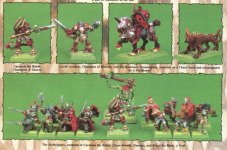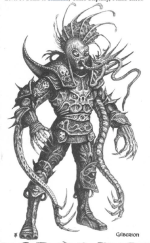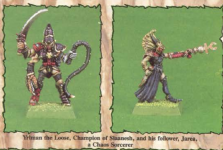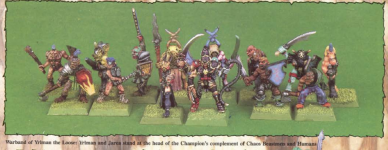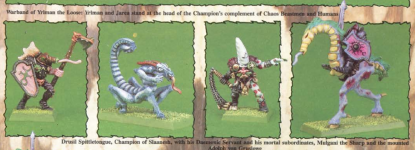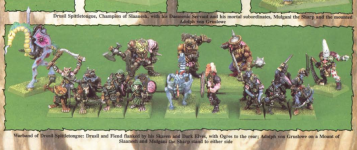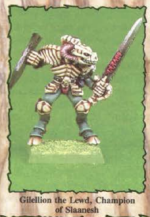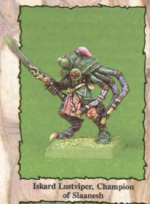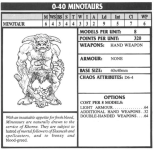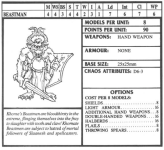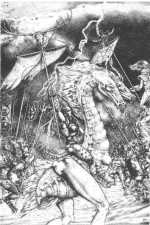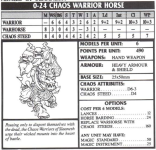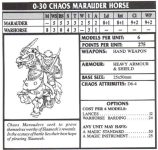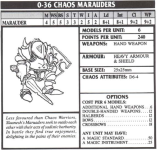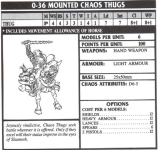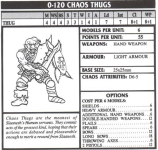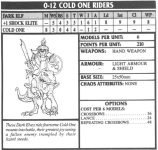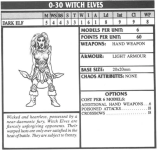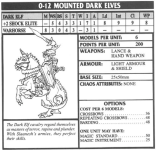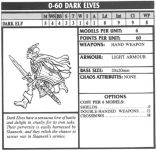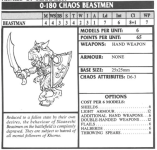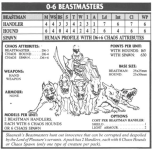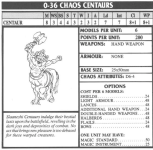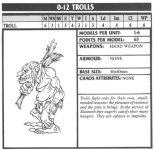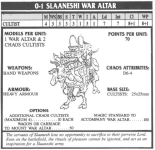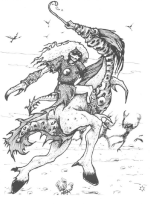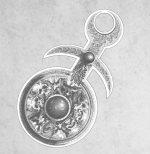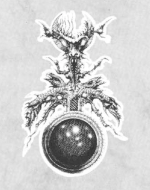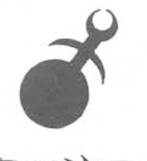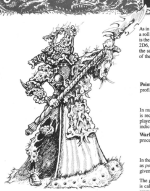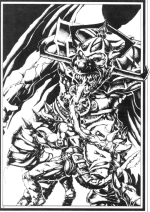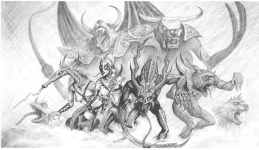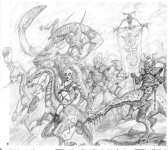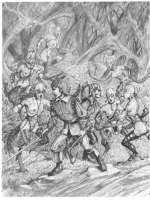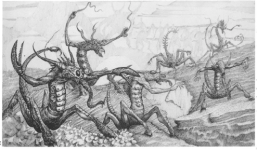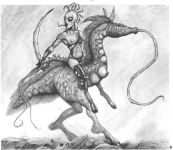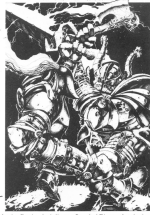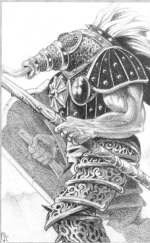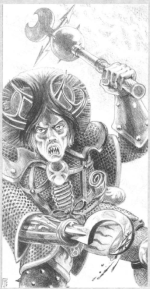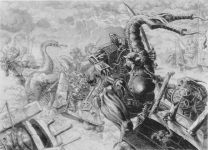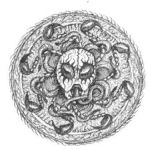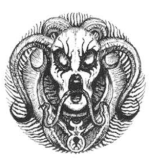COLOURS OF CHAOS
Whether you intend to field an army of Chaos followers, use individual miniatures for a roleplaying adventure or just collect Realm of Chaos figures, they will onlyNlook truly grotesque after they have been painted. Given the number of mutation permutations, the potential for converting miniatures is also great. But the Powers and their followers demand special attention in this respect, for who is to say what coir an eel should be? And how mutated can you make a mutant? Perhaps the master of all things miniature, John Blanche, can answer.
Realm of Chaos miniatures provide plenty of scope for the imaginative and adventurous miniature figure painter to experiment. Painting your miniatures normally yields the best results as gaudy colour schemes can drown a figure. But when you consider the subject matter here, bright green hair or sky blue skin for the followers of the mighty gods of Chaos sounds perfectly reasonable. Perhaps anything goes. Or does it? The choice is yours, obviously, but to be really convincing it pays to show some restraint and apply some sort of themes for your choice of Chaos colour schemes. The Powers - Khorne, Slaanesh, Nurgle and Tzeentch - suggest themes by virtue of their different characteristics, which themselves cater for most tastes, from the gaudy to the militaristic. A livery mainly composed of the martial colours (red, black and brass) suits the followers of Khorne perfectly, whereas Slaanesh has pale skinned followers bedecked in pastel shades, offset by shiny black leather and studs.
By bearing this in mind, your figures, and in particular your units and armies, will have an overall coherence which proves to be more striking than the result of adopting a free for all approach with the palette. If your warbands of mutants and Champions don’t bear allegiance to one particular Power, or if they operate covertly, apply a naturalistic ) colour scheme (in a suitably horrible tone). Nature itself provides an endless reference source, covering every conceivable pattern and colour combination. So where flesh, hide, scale or fur appear, if you are stuck for a colour scheme, a quick glance through a natural history book should be enough to trigger your imagination. Of course, naturalistic should also mean authentic, so be selective and bear in mind the nature of Chaos. Cloth should be painted as cloth and metal as metal etc, but feature colours that are associated with fear, the unknown, corruption. Black, offset or picked out with red and brass, has been a favourite colour scheme for Chaos Champions employed by
Citadel figure painters for some time. A fair degree of dark green has also been used by artists when dealing with chaotic subject matter, probably because of its association with things slimy and tentacled. It’s also a very useful colour to use as an alternative to black, because black cannot be shaded, only highlighted. Green therefore is a little more versatile to the miniatures artist.
Whether you intend to field an army of Chaos followers, use individual miniatures for a roleplaying adventure or just collect Realm of Chaos figures, they will onlyNlook truly grotesque after they have been painted. Given the number of mutation permutations, the potential for converting miniatures is also great. But the Powers and their followers demand special attention in this respect, for who is to say what coir an eel should be? And how mutated can you make a mutant? Perhaps the master of all things miniature, John Blanche, can answer.
Realm of Chaos miniatures provide plenty of scope for the imaginative and adventurous miniature figure painter to experiment. Painting your miniatures normally yields the best results as gaudy colour schemes can drown a figure. But when you consider the subject matter here, bright green hair or sky blue skin for the followers of the mighty gods of Chaos sounds perfectly reasonable. Perhaps anything goes. Or does it? The choice is yours, obviously, but to be really convincing it pays to show some restraint and apply some sort of themes for your choice of Chaos colour schemes. The Powers - Khorne, Slaanesh, Nurgle and Tzeentch - suggest themes by virtue of their different characteristics, which themselves cater for most tastes, from the gaudy to the militaristic. A livery mainly composed of the martial colours (red, black and brass) suits the followers of Khorne perfectly, whereas Slaanesh has pale skinned followers bedecked in pastel shades, offset by shiny black leather and studs.
By bearing this in mind, your figures, and in particular your units and armies, will have an overall coherence which proves to be more striking than the result of adopting a free for all approach with the palette. If your warbands of mutants and Champions don’t bear allegiance to one particular Power, or if they operate covertly, apply a naturalistic ) colour scheme (in a suitably horrible tone). Nature itself provides an endless reference source, covering every conceivable pattern and colour combination. So where flesh, hide, scale or fur appear, if you are stuck for a colour scheme, a quick glance through a natural history book should be enough to trigger your imagination. Of course, naturalistic should also mean authentic, so be selective and bear in mind the nature of Chaos. Cloth should be painted as cloth and metal as metal etc, but feature colours that are associated with fear, the unknown, corruption. Black, offset or picked out with red and brass, has been a favourite colour scheme for Chaos Champions employed by
Citadel figure painters for some time. A fair degree of dark green has also been used by artists when dealing with chaotic subject matter, probably because of its association with things slimy and tentacled. It’s also a very useful colour to use as an alternative to black, because black cannot be shaded, only highlighted. Green therefore is a little more versatile to the miniatures artist.
'It's nothing like me! You promised me that it would be an excellent likeness. Two hundred you've had for this and for this...odure.' Von Gottschalk was furious. He prodded the offending bronze statue with his walking stick.
The artist wiped the mark from the statues foot with a soft cloth. He sighed.
Two hundred barely covered my materials, my lord. The portrait is exact, taken from the cartoons I prepared last month. The posture is yours, the demenour military and noble, the size as specified, no more than two feet. You saw and approved the waxes.
'It is rubbish. And now I suppose you'll want your final three hundred eh? Well damn you, I won't pay.'
The artist said nothing as Von Gottschalk left. He stood by the window and watched the pompous fool stride down the street, 'Be careful who you damn, fool.'
By midnight all was finished. The chalk markings on the artists work table had been the hardest job , so precise and all to be drawn from memory but now Von Gottschalk's statue stood in the middle of the largest chalk circle. Even the girl he had chosen from the street below was ready to do her part. Gold had cured her reluctance. The artist picked up a mallet, testing its balance and weight. Perfect. He began to whisper softly, the room became warm.
The girl stepped forward, and ran a finger down the statue. She caressed it and stroked it, traced its contours and shapes. Her fingers left faint lines of sweat and greese on the bronze. The artist's whisper became a faint chant.
Von Gottschalk stirred from his dreams. A piece of cheese or too much of that Tilean wine no doubt, he rolled over.
The artist's eyeballs were rolled back, his breath was a hoarse rasp, a single word endlessly repeated. The mallet was raised above his head.
'Slaanesh! Slaanesh! Slaanesh!"
The girl turned and shrieked. The mallet came down with all the artist's strength. The statue toppled slowly as if held up by some unseen hand. It's head was cracked and as it landed the face fell off.
In his bed Von Gottschalk fell silent.
Last edited:



